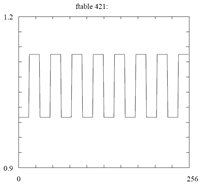This is a work in progress…
Today we hear from some new sections. Trills are handled by multiplying a note by a function table, like one shown on this page. The numbers represented by the graph are generated in csound with the following code:
f 421 0 256 -7 1 16 1 0 1.1249114 16 1.1249114 0 1 16 1 0 1.1249114 16 1.1249114
0 1 16 1 0 1.124911356 16 1.124911356 0 1 16 1 0 1.124911356 16 1.124911356
0 1 16 1 0 1.124911356 16 1.124911356 0 1 16 1 0 1.124911356 16 1.124911356
0 1 16 1 0 1.124911356 16 1.124911356 0 1 16 1 0 1.124911356 16 1.124911356 ; 9 : 8 120 up & down 9
I tell Csound what function table to multiply the note by, and then get a trill. In this piece, the C is tone 0, D a 9:8 above is tone 9, and E a 5:4 above C is tone 17. I multiply the C by the function number 421, and it trills from C to D. I create a triad with C, E, G, also known as 4:5:6 in just, and trill it to D, F+, A+, also known as 9:11:14. With a certain amount of randomness, it might play zero, one, two, or three notes at a time.


